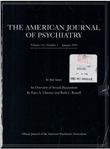Self-mutilation in personality disorders: psychological and biological correlates
Abstract
OBJECTIVE: The goal of this study was to determine whether self- mutilators with personality disorders differ from nonmutilators with personality disorders in impulsivity, aggression, and other psychopathology and whether serotonergic dysfunction contributes to self-mutilation. METHOD: Twenty-six self-mutilators with personality disorders were matched to 26 control subjects with personality disorders for gender, age, education, axis I diagnosis of affective disorder, and axis II diagnosis of personality disorder. Numerous indexes of psychopathology as well as CSF 5-hydroxyindoleacetic acid (5- HIAA) levels and platelet imipramine binding sites (Bmax) and affinity (Kd) were determined. RESULTS: Self-mutilators had significantly more severe character pathology, had greater lifetime aggression, and were more antisocial than the control subjects. The self-mutilators scored higher on the Hamilton Rating Scale for Depression but not on the Beck Depression Inventory or the Beck Hopelessness Scale. The two groups did not differ on the Buss-Durkee Hostility and Guilt Inventory or on the Sensation Seeking Scale. The degree of self-mutilation was significantly correlated with impulsivity, chronic anger, and somatic anxiety. Both self-mutilation and impulsivity showed significant negative correlations with Bmax, although the two groups did not differ in CSF 5-HIAA levels or in platelet imipramine binding. CONCLUSIONS: The results demonstrate the contribution of severe character pathology, aggression, impulsivity, anxiety, and anger to self-mutilation and provide preliminary support for the hypothesis of underlying serotonergic dysfunction facilitating self-mutilation.
Access content
To read the fulltext, please use one of the options below to sign in or purchase access.- Personal login
- Institutional Login
- Sign in via OpenAthens
- Register for access
-
Please login/register if you wish to pair your device and check access availability.
Not a subscriber?
PsychiatryOnline subscription options offer access to the DSM-5 library, books, journals, CME, and patient resources. This all-in-one virtual library provides psychiatrists and mental health professionals with key resources for diagnosis, treatment, research, and professional development.
Need more help? PsychiatryOnline Customer Service may be reached by emailing [email protected] or by calling 800-368-5777 (in the U.S.) or 703-907-7322 (outside the U.S.).



